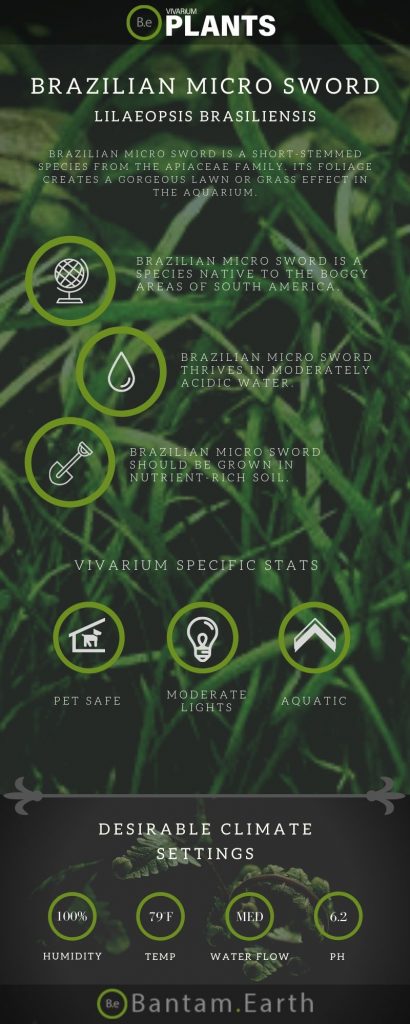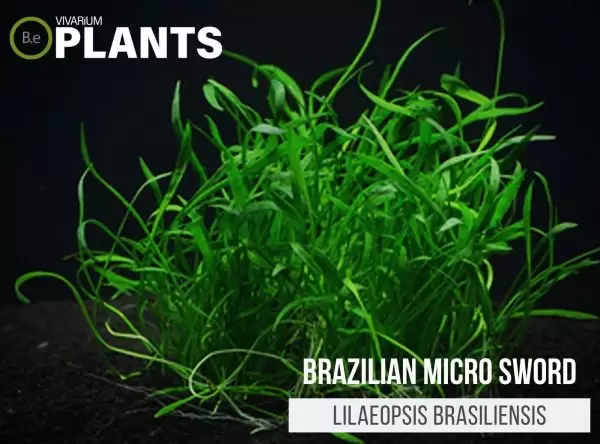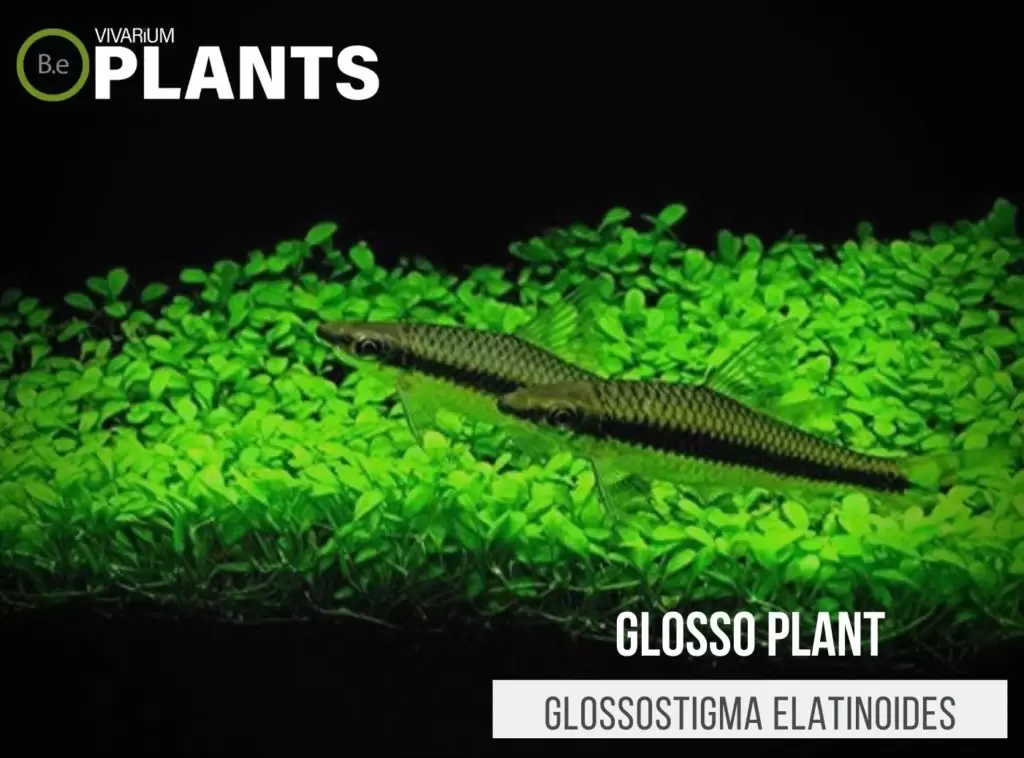One of the most visually intriguing vivarium plants that can be used as carpeting grass is the Brazilian Micro Sword.
It is especially popular in the aquarium community due to its hardiness and attractiveness.
This article will take a closer look at the Lilaeopsis brasiliensis, providing a complete understanding and care guide to properly growing one.
| Quick Stats: | |
|---|---|
| Scientific Name | Lilaeopsis Brasiliensis |
| Common Name | Brazilian Micro Sword, Micro Sword Grass, Copragrass, Carpet Grass |
| Family Name | Apiaceae |
| Habitat | Freshwater |
| Temperature | 72°F to 85°F |
| Height | 4 - 7in |
| pH | 5.0 to 7.5 |
| Lighting | Moderate |
Table Of Contents:
ToggleWhat Is Brazilian Micro Sword?
The Brazilian Micro Sword is a short-stemmed species from the Apiaceae family.
It is very well known amongst hobbyists in the freshwater aquarium world.
It is an ideal foreground plant for almost all setups. Its foliage creates a gorgeous lawn or grass effect in the vivarium.
Aside from its aesthetical benefits, the Brazilian Micro Sword also serves as a great place for spawning fish and other small creatures to lay their eggs.
In addition, it is also a very useful hiding place for small critters.
Even though it is often used by amateurs in the field, this plant is considered of moderate difficulty when it comes to its upkeep.


Brazilian Micro Sword Facts
The Brazilian Micro Sword plant is botanically known as Lilaeopsis brasiliensis. Besides its scientific name, it is also commonly referred to as Micro Sword Grass, Copragrass, and Carpet Grass.
It belongs to the family Apiaceae under the order Apiales of Class Magnoliopsida.
Due to their similar appearance, L. Brasiliensis is often confused and even sold as Lilaeopsis Novae-Zelandiae.
However, Brasiliensis is actually a subspecies of the other.
They are almost identical, with the exception that Brasiliensis is noticeably shorter in height.
It was first discovered in 1909 by Glazion and categorized under the genus Crantzia.
However, in 1985 it was moved into the Lilaeopsis genus by J.M. Affolter. The genus Lilaeopsis was created by the American botanist Edward Lee Greene.
The genus name Lilaeopsis means “charming the eye” while the species name Brasiliensis is Latin and was given because of its native habitat of Brazil.
Description
Brazilian Micro Sword is often described as looking a lot like common grass. It is actually very similar in appearance to Dwarf Hairgrass.
However, its foliage is a thinker and shinier than the other species. The leaves don’t have a traditional round or oval shape.
Instead, they are flat, narrow at the bottom, and wider towards the middle.
They are also light green in color, have somewhat of a pointy top, and sprout from very small branches.
Lilaeopsis brasiliensis grows along a rhizome, which sends out shoots and roots from its nodes.
Those roots are diminutive, very thin, and white in color. The plant is mostly known for its carpeting style and moderate growth speed.
The species is labeled as “Micro” due to its small and compact size, especially compared to its mother plant L. Novae-Zelandiae.
At its full size, the blades will reach a height of 4 to 7 inches. The height will almost always depend on how much light it is receiving.
In most aquariums, it will usually not grow more than 2 or 3 inches. That is unless the hobbyist provides more of a high-tech setup.
Habitat
The Brazilian Micro Sword is a species native to South America, especially Brazil.
It can usually be seen growing in wetlands, banks of ditches, swamps, lakes, and streams of Brazil as well as Argentina and Paraguay.
Due to its origin, it requires tropical climates to thrive.
With that being said, the ideal temperature for this grass’s optimal growth falls anywhere between 72 to 84 degrees Fahrenheit.
In all of its natural locations, the plant occurs both fully submerged as well as emerged.
This means that Lilaeopsis brasiliensis will grow completely underwater or it can be rooted in shallow water with much of its foliage growing above the water.
pH Preference
Brazilian Micro Sword tends to thrive within acidic to neutral pH levels. Extremely alkaline levels should be avoided.
The pH level of water measures the relative acidity or alkalinity based on a scale of about 0 to 14. A pH of 7 represents neutral levels, meaning neither acidic nor alkaline.
Even though the hypothetical range of pH is actually a lot wider when it comes to plants the range used is typically between 4 (highly acidic) and 10 (highly alkaline).
The ideal pH for Lilaeopsis brasiliensis will range anywhere between 5.0 and 7.5.
Vivarium Type
Brazilian Micro Sword is a very interesting plant that can thrive in a few different vivarium types.
However, it is a strictly aquatic plant and will not survive in an enclosure that does not have significant amounts of water features.
When deciding if rather or not to use this plant in a particular type of enclosure, it is a good idea to go with setups that have significant amounts of added lighting.
A low-tech vivarium might not be able to provide an adequate amount of light for the plant’s success.
Here are recommended vivariums Lilaeopsis brasiliensis will do well in:
- Paludariums – Half aquatic/ half terrain-based enclosure.
- Ripariums – Mostly aquatic-based enclosures with some terrain features present.
- Aquariums– Fully aquatic-based enclosure with little to no dry terrain.
Vivarium Placement
As mentioned before, the Brazilian Micro Sword is a type of aquatic plant.
Even though its roots must be planted in water, the foliage does not need to be fully submerged.
Just like in its natural habitat, the plant can thrive in an enclosure when cultivated emersed.
Therefore, as long as it is planted in the water this grass-like vegetation can be placed anywhere.
The exact location where Lilaeopsis brasiliensis is placed will ultimately depend on the person growing it.
However, it is most commonly used as a foreground cover.
Its carpeting style and low growth make it the perfect tool to cover the ground area and create a very natural look.
Aside from helping the tank aesthetically, placing it towards the bottom will also serve as a breeding or hiding spot for the smaller creatures.
Substrate
Brazilian Micro Sword should be grown in nutrient-rich soil.
Although there is no specific substrate that must be used, finding the right one can have a significant impact on the plant’s health.
A good substrate with nutritious macronutrients will help Lilaeopsis brasiliensis reach its full potential.
An alternative solution to finding the perfect substrate will be supplementation.
Regularly adding liquid fertilizer is another safe option, as long as it is done properly.
The fertilizer used should have phosphates, nitrate, and other micro-nutrients.
A good example of a fertilizer that can be used would be Seachem Flourish Excel Bioavailable Carbon.
Keep in mind that the product should not be used when cycling the tank.
It has antibacterial properties, which can end up killing beneficial bacteria and disrupting the cycle.
Lighting
Brazilian Micro Sword can survive and do quite well in a variety of conditions.
However, the amount of light that the plant receives will definitely be a deciding factor in its growth.
For the foliage to reach its full potential and size, the light intensity provided should be 2 to 3 watts per gallon of water or more.
Full-spectrum bulbs of 5000 to 7000K are highly recommended.
In addition, T8 or T5 fluorescent tubes can be used in the set-up, as well as LED lighting.
Nonetheless, Lilaeopsis brasiliensis can still grow in lower lighting or shaded area.
However, the coveted and famous lawn effect will most likely not be achieved.
Buy Brazilian Micro Sword
When looking to buy a Brazilian Micro Sword, there are a few things that should be kept in mind.
If purchasing from a physical store, make sure to look for a plant with vibrant green leaves that are at least about 2 inches long.
Avoid plants that simply do not look healthy at first glance.
For instance, cracked, yellowing leaves, that have dead tips or are torn are always a big no-no.
Another clear indicator of Lilaeopsis brasiliensis’ health is the presence of algae. Batches with any visible amount of algae should immediately be averted.
Algae is a fast and vicious spreader, any small traces of it can potentially contaminate an entire vivarium.
The same criteria should apply to vegetation that is purchased online.
Always buy from trustworthy and reputable sources that have overall good reviews. Once the batch arrives, check the plant for all of the above signs.
Click the image below to find out more about the current price and other relative info on Brazilian Micro Sword for sale:
Brazilian Micro Sword Care and Propagation
Brazilian Micro Sword requires a bit more attention than some other aquatic plants.
Not be discouraged, that does not mean that you must be an expert in order to have successful growth.
The plant will simply not be as forgiving of neglect or a poor setup.
The main things to keep in mind to promote healthy growth will be proper lighting, nutritious substrate, and good water flow.
As long as those needs are being met, Lilaeopsis brasiliensis should do quite well and achieve a very full, vivid, and healthy look.
Another aspect to keep in mind is what kind of tank mates the species will have.
Although the plant can be kept with most community fish species, herbivores and more “aggressive” fish should be avoided.
Large stirred cichlids, Oscars, Jack Dempseys, and goldfish will most likely end up damaging the foliage.
How to grow
The propagation of Brazilian Micro Sword is pretty much the same as many other grass plants.
Both species will naturally generate runners that branch off the root area. These then develop into a new plant and will grow from the root up.
Lilaeopsis brasiliensis can easily be left alone and this process will happen automatically without needing any real human interaction.
If allowed to propagate on its own, it will perform its very popular carpet effect in the substrate of the vivarium and can provide a very striking aquascape.
The runners can also be pinched off and replanted somewhere different in order to accelerate the process as well as create a compact carpet look.
Watering
Since Brazilian Micro Sword is an aquatic plant that should not be planted above water, it will not require to be watered.
It will automatically take whatever water it needs from being underwater. However, the species will most definitely like a very nutritious diet.
As mentioned before, liquid fertilizer as well as added CO2 will be extremely beneficial to its health and appearance.
Another thing to look out for is pesky algae growth. Dwarf Hairgrass tends to be very dense, which can accumulate a lot of debris and promote algae growth.
Making sure that there is a slow but steady water current can help alleviate this issue.
Periodic water changes will also help make sure that the water conditions are kept within proper ranges.
Plants Similar To Brazilian Micro Sword
Adding diversity to an enclosure is key to an aesthetically pleasing setup.
Try mixing up the look of your vivarium with different flora that can easily co-exist in the same types of environment.
Furthermore, if for some reason you find Brazilian Micro Sword hard to acquire or would like to consider something similar to this plant…
Here are some other plants you might find may do well with or in the place of Lilaeopsis brasiliensis:
Conclusion
Although Brazilian Micro Sword might not be the easiest plant to grow, it is definitely worth the effort.
Not only is it an amazing aquascaping tool, but it is also extremely beneficial to the animals and critters living in the tank.
Its petite growth also makes it a very versatile and functional vivarium plant. Meaning that the grower will have more freedom when it comes to its placement.
Lilaeopsis brasiliensis will do just as well in a large tank, as it will in a Nano tank. There aren’t too many plants that can do both nearly as well!




